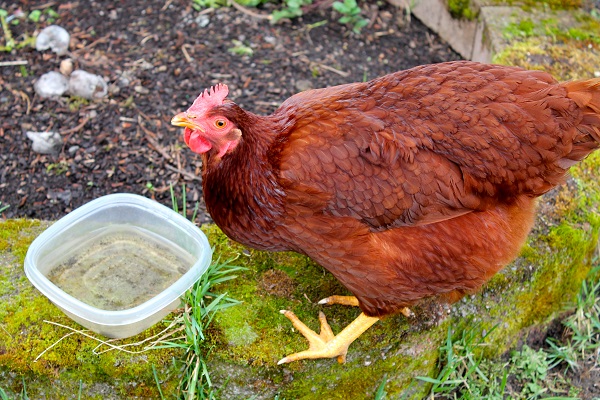

Water is a critical, but often overlooked, nutrient. Animals can survive longer without food than they can without water. Water is involved in every aspect of animal metabolism. It plays an important role in regulating body temperature, digesting food, and eliminating wastes. At normal temperatures, chickens typically consume twice as much water as feed. During periods of high temperature, water consumption can double or quadruple. To remain healthy, poultry flocks require water of adequate quality and quantity.
Several factors influence water quality, including the color, taste, and odor of water, as well as the presence of bacteria or other microbes, the levels of minerals, and other chemical and physical factors.
Color, Taste, and Odor. It is important that drinking water be clear, tasteless, odorless, and colorless. Water that is contaminated exhibits different characteristics depending on the contaminants.
The presence of particles such as clay, silt, or organic material can make water cloudy. Such water can interfere with the proper operation of watering equipment and can indirectly lead to adverse effects on flock performance.
Water that is reddish-brown might contain excess iron. A blue hue to water can be an indication of excess copper. A rotten egg smell is an indication of hydrogen sulfide in water. Hydrogen sulfide may also combine with iron to form black water (iron sulfide), which can also indicate the presence of sulfate-reducing bacteria.
The taste of water can be affected by the presence of different salts. A bitter taste, for example, is associated with the presence of ferrous and manganese sulfates.
Mineral Content
A large number of minerals occur naturally in water. They are usually present in amounts that do not interfere with the metabolism or digestive functions of poultry. When the levels of certain minerals are out of balance, however, poultry performance can be adversely affected.
Nitrates and Nitrites
Nitrogen contamination of water usually occurs in the form of nitrates and nitrites. Nitrate (NO3) is produced during the decomposition of organic matter. Nitrite (NO2) is produced during intermediate stages of the decomposition of organic compounds. The presence of nitrates and/or nitrites in water usually indicates that the water is contaminated by runoff containing fertilizer or animal wastes. Nitrates are soluble and may move with surface runoff or leach into the groundwater by percolation through the soil. Nitrate itself is not toxic, but after consumption, microorganisms found in the avian digestive tract convert nitrate to the more toxic form of nitrite. Once nitrite is absorbed into the bloodstream, it binds strongly with hemoglobin (which normally carries oxygen) and reduces the oxygen carrying capacity of the blood. Long-term nitrate and/or nitrite toxicity results in poor growth, decreased feed consumption, and poor coordination.
Sulfate (SO4)
In the presence of magnesium or sodium, high sulfate levels have a laxative effect. Levels as low as 50 mg/L can have a negative effect on flock performance if either the sodium or magnesium level is also 50 mg/L. High levels of sulfate may also interfere with intestinal absorption of other minerals such as copper.
Phosphate (PO4)
High levels of phosphate may indicate water contamination from sewage.
Sodium (Na)
Excessive levels of sodium have a diuretic effect. The normal sodium level in water is about 32 mg/L. Levels above 50 mg/L, together with high levels of sulfate or chloride, have been shown to adversely affect flock performance. High levels of sodium also increase water consumption and litter moisture. This can have an adverse affect on air quality in the poultry house.
Chloride (Cl)
Excessive levels of chloride have been shown to adversely affect metabolism. A normal chloride level is 14 mg/L. Levels of about 14 mg/L, combined with a level of 50 mg/L of sodium, are detrimental to flock performance. Poultry can tolerate chloride levels as high as 25 mg/L as long as the sodium level is in the normal range. High levels of chloride increase water consumption and litter moisture.
Magnesium (Mg)
The normal level of magnesium in water is about 14 mg/L. Poultry that consume water containing high levels of magnesium have loose droppings. Magnesium may interact with sulfate, and it is in the presence of high sulfate levels that magnesium levels are a concern. Levels as high as 68 mg/L have not been shown to adversely affect production when sulfate levels are normal. A level of 50 mg/L of magnesium in combination with a sulfate level of more than 50 mg/L will adversely affect flock performance.
Manganese (Mn)
Excessive levels of manganese can result in an off flavor, reducing water consumption.
Copper (Cu)
In combination with phosphorus, copper plays a role in bone development. Ruminants are more susceptible to copper toxicity than poultry. Too much copper can give the water a bitter taste and might cause liver damage. Problems with copper can occur when dietary molybdenum is either excessive or deficient.
Calcium (Ca)
Calcium does not appear to have a negative effect, even at levels as high as 400 mg/L.
Iron (Fe)
High levels of iron, up to 25 mg/L, have not been shown to adversely affect flock performance, but they will stain waterers. High iron levels may encourage the growth of bacteria that can lead to diarrhea. When iron in the ferrous form is exposed to air, it is converted to ferric hydroxide, which gives water the typical rusty color.
 Contact Jaguza Support
Contact Jaguza Support